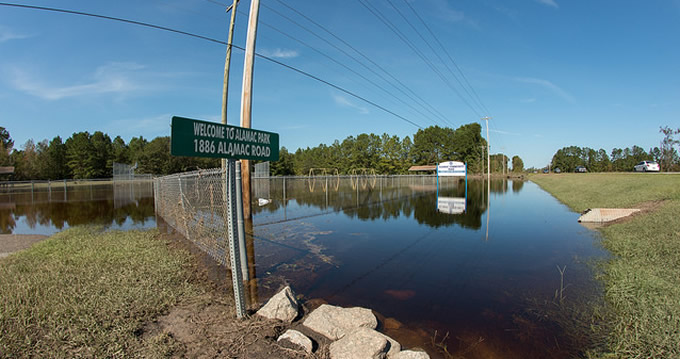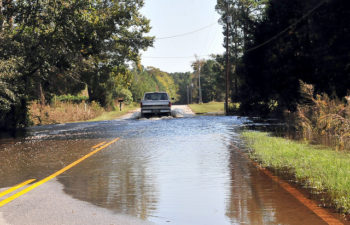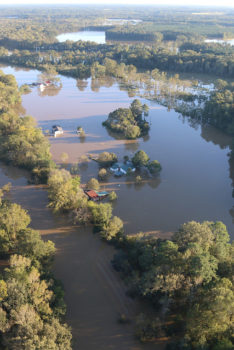Will families be protected from the next flood?
A changing climate will bring more storms and floods, we need to adapt to changing conditions.

A quarter million homes were damaged, 93 dams failed and 52 lives were lost. Will we learn from the historic October floods of 2015 and 2016?
For decades scientists have been warning us that a warmer climate will bring more frequent and more violent storms to the Southeast. While the models are complex the concept is simple. Warmer temperatures evaporate more water adding more moisture to the atmosphere. This leads to more precipitation and more large storms.

Flooded roads in Andrews, South Carolina in October 2015, thanks to Hurricane Juaquin. | North Carolina National Guard
That is exactly what happened in the Carolinas during back to back years with historic October storms. In 2015, South Carolina witnessed these predictions come true as the remnants of Hurricane Joaquin collided with a stalled weather system turning on a meteorological fire hose that dumped record setting rains across much of the state – two feet or more for some communities.
North and South Carolina are still recovering from the October 2016 winds and flooding from Hurricane Matthew. At least 10 North Carolina counties received eight or more inches of rain in 24 hours setting off catastrophic floods. The Waccamaw River in South Carolina crested at 17.89 feet exceeding the 2015 flood by one and a half feet, and breaking the all-time flood record that stood for 88 years.
The 2015 and 2016 floods combined damaged more than a quarter million homes, caused 93 dams to fail and, most tragically, resulted in the loss of 52 lives. The 2015 floods are South Carolina’s second most costly environmental disaster causing more than $12 billion of economic impacts. Once summary information is available, the 2016 floods will certainly rank among North Carolina’s top environmental disasters.

Flooding from Hurricane Matthew damages homes near Selma, North Carolina, October 12, 2016. | U.S. Army National Guard
Flooding is becoming more frequent and more severe.
The impacts of floods out rank all other natural hazards and predictions indicate that the size of nation’s floodplains will grow by 40 to 45% by the end of the century putting even more communities in harm’s way. We must adapt to changing conditions to ensure the safety of our citizens, their homes and our roadways from increasing storms and floods.
The political leaders of the Carolinas have largely ignored decades of warnings from scientists relying instead on a business-as-usual approach to floodplain development, poorly planned growth and dam safety. North Carolina actually outlawed the use of climate science for evaluating future sea level rise.
Will the lives lost, property damaged and dams failed be enough to convince the states’ leaders that we cannot continue business as usual?
Here are commonsense solutions to adapt to increasing floods that both states should put in place to save lives and protect property.
- Protect and restore floodplains: Naturally functioning floodplains store floodwaters and reduce downstream flooding. We need to take advantage of these natural defenses.
- Get people out of harm’s way: Poorly planned growth has allowed development in flood prone areas, putting people in harm’s way. We need to replace developed areas with green spaces that can absorb floodwaters and buffer communities from damages. Charlotte, Milwaukee and Davenport, Iowa have been leaders in taking 21st century approaches for water and flood management.
- Strengthen state dam safety laws and programs: Ninety-three failed dams make it clear that our current standards, especially for earthen dams which are by far the most likely to fail, do not provide safety with the reality of today’s extreme flooding.
- Remove dams that do not meet safety requirements: We cannot wait until dams fail to take action. Poorly maintained and improperly designed dams need to be removed to protect downstream communities and infrastructure before they fail.
The leaders of North and South Carolina must learn from the disastrous floods of 2015 and 2016, and enact 21st century solutions that protect families from future floods. We must adapt to changing conditions and cannot continue business as usual while lives are lost and communities are devastated.




1 response to “Will families be protected from the next flood?”
I’ve been a proponent for dam removal for 5 or 6 years. I’ve been mainly concerned with the lower Snake River dams that need to be breached to improve the chance of Salmon survival in the Columbia River system. It appears that the individuals in charge of dams in your area need to take a serious look at your options for dam removal. Most dams in our country are approaching their end date for lack of a better term. It’s usually cheaper to get rid of them then the maintenance costs associated with keeping them.